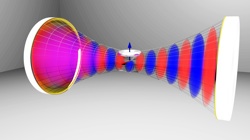Measuring the Magnetism of Light
Light is a wave of both electric and magnetic fields, but when these waves strike matter, the weaker effect of the magnetic component has been nearly impossible to detect directly. Now two groups have independently demonstrated that a tiny, metallic probe will interact strongly with the magnetic field of light waves trapped in a sort of semiconductor “box.” As described in a pair of papers in the 17 September Physical Review Letters, a similar set-up could be used either to measure the high frequency magnetic properties of individual nano-scale objects, or to map the magnetic field inside so-called metamaterials that can control light in new ways.
When light interacts with matter, the dominant action is often a “shaking” up and down of electrons in response to the electric field. This interaction is typically 10,000 times larger than the “swirling” action from a light wave’s magnetic field. The case is different in metamaterials, which contain small components like metal rings that are often tailored to have an enhanced response to magnetic fields. Thanks to this sensitivity, light traveling through a metamaterial can bend in unusual ways, making feasible such devices as super-lenses and invisibility cloaks.
Previously, researchers could measure the magnetic interaction between light and some form of matter only by subtracting the dominant electric interaction from the total effect of the light. Now two experimental groups have managed to directly isolate the magnetic field effect. They worked with a type of 2-dimensional device called a photonic crystal microcavity. The crystal is fabricated by perforating a thin layer of semiconductor with a pattern of tiny holes, like a micron-sized punch card. The cavity is made by leaving a small region “un-punched” and letting the surrounding lattice of holes act like mirrored walls that keep infrared light bouncing around in the cavity as standing waves.
In the last few years, researchers have been characterizing the trapped light in photonic cavities by bringing the tip of a needle-shaped optical fiber within nanometers of the surface. This probe perturbs the electric field and shifts the trapped light to longer wavelengths. The new experiments used a fiber tip coated with a thin layer of aluminum that covers all but the very bottom of the tip. This “tube” of metal acts like a ring a few hundred nanometers across.
Both research teams were at first surprised to find that these metal rings caused a blue-shift in the trapped light. But later they realized that according to classical electrodynamics, the light’s oscillating magnetic field induces a current in the tip’s metallic ring, which creates a secondary magnetic field that points in the opposite direction to the original. This field cancels out some of the magnetic field in the cavity and thereby reduces the volume for the trapped light. Less volume means shorter, bluer wavelengths. “It’s like playing guitar,” says Tobias Kampfrath of the FOM Institute for Atomic and Molecular Physics (AMOLF) in Amsterdam. “If you make the guitar strings shorter, the resonant wavelengths will shorten as well.”
A team including Kampfrath, AMOLF’s Kobus Kuipers, and others, was able to measure a blue-shift of about 0.03 percent with their cavity and probe. They combined this with an estimate for the cavity’s maximum magnetic field to obtain the magnetic properties of their nano-sized ring. The results matched theoretical expectations, so the authors suggest this method could be used to measure the magnetic response of other small objects, such as carbon nanotubes or even single atoms. They also recently performed a variant on this experiment, in which they used a tip with an open ring to probe the magnetic field of propagating (untrapped) light [1].
The other group’s experiment was similar, except that they gleaned different information from the magnetic interaction. Instead of measuring the ring’s properties, Silvia Vignolini, now at the University of Cambridge, Diederik Wiersma of the European Laboratory for Non-linear Spectroscopy (LENS) in Florence, Italy, and their collaborators, scanned their metal-coated tip over the photonic crystal surface to construct an image showing the spatial patterns of the magnetic field.
“The imaging itself is nice,” says Claus Ropers, of the University of Göttingen in Germany, “but the real breakthrough of these works lies in the quantitative extraction and potential control over local magnetic interactions and coupling strengths.” Harald Giessen of the University of Stuttgart compares the experiments to the late 19th century work of Heinrich Hertz, who used a ring-shaped antenna to map the magnetic fields of radio waves. Giessen believes these new probing techniques will prove useful in the fabrication of novel optical devices.
–Michael Schirber
Michael Schirber is a Corresponding Editor for Physics Magazine based in Lyon, France.
References
- M. Burresi, D. van Oosten, T. Kampfrath, H. Schoenmaker, R. Heideman, A. Leinse, and L. Kuipers, “Probing the Magnetic Field of Light at Optical Frequencies,” Science 326, 550 (2009)
More Information
Photonic Metamaterials (from RP Photonics)
introduction to the optical probing technique (NSOM) used in the experiments (from Olympus)





